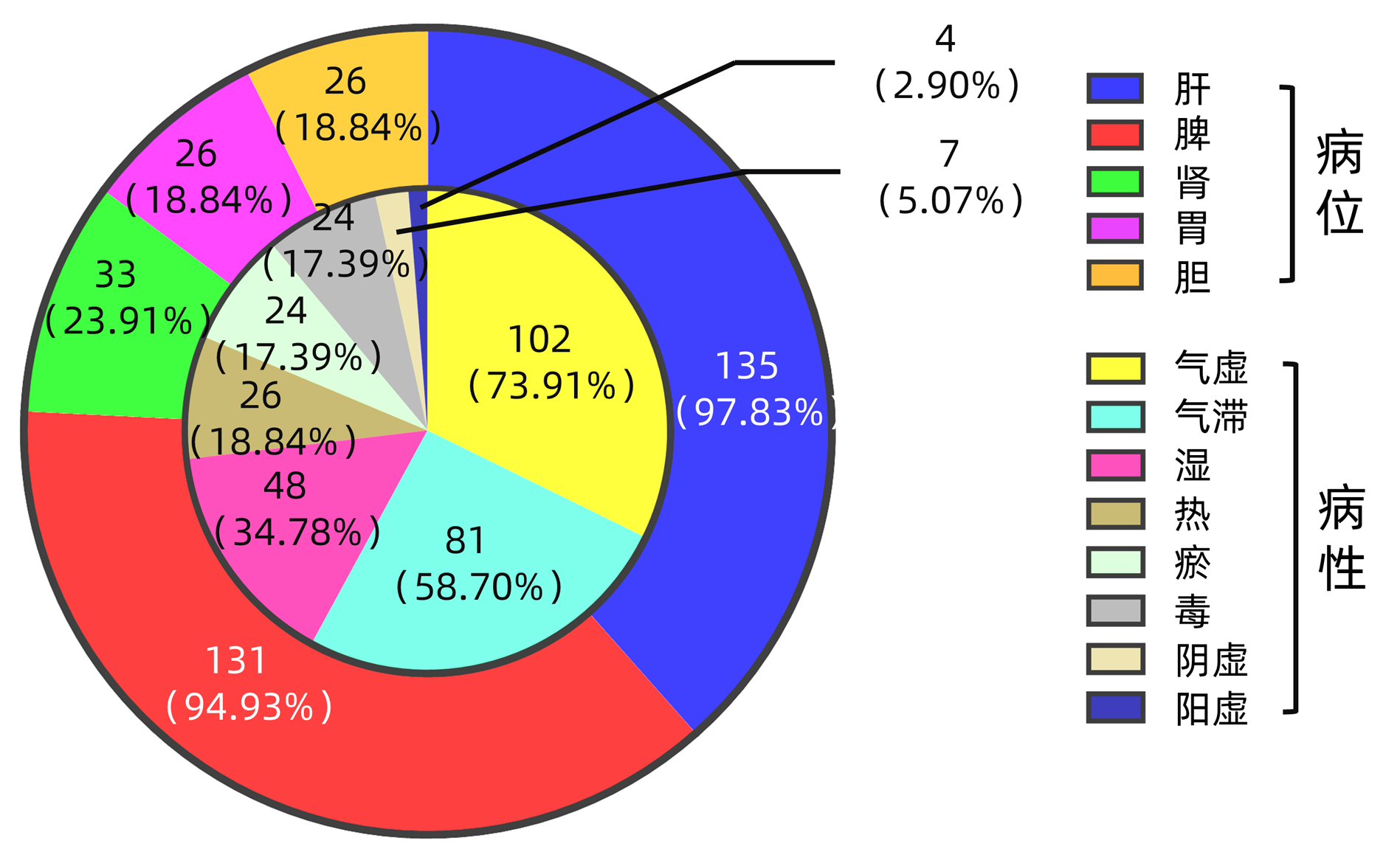138例肝硬化不典型增生结节患者中医证型证素分布分析
DOI: 10.3969/j.issn.1001-5256.2023.02.015
Distribution of traditional Chinese medicine syndrome types and elements in liver cirrhosis patients with dysplastic nodules: An analysis of 138 cases
-
摘要:
目的 探讨肝硬化不典型增生结节(DN)的中医证型证素分布规律,为探索肝硬化DN中医证候内涵和规律提供依据。 方法 纳入2013年3月—2021年1月就诊于河南中医药大学第一附属医院诊断为肝硬化DN的患者共138例。采集患者的发病年龄、性别等一般资料,记录病因、中医证候、肝功能Child-Pugh分级资料,归纳中医证型、证素分布特征。计数资料组间比较采用χ2检验或Fisher精确检验。 结果 肝硬化DN患者病位证素以肝、脾为主(97.83%、94.93%),其次为肾(23.91%);病性证素以气虚、气滞为主(73.91%、58.70%),其次为湿(34.78%);中医证型主要为肝郁脾虚证、湿热内盛证、瘀毒蕴结证、水湿内阻证,以肝郁脾虚证多见(58.70%),显著高于其他证型(P<0.05);中医证型与性别、年龄、病因等比较,差异均无统计学意义(P值均>0.05)。不同中医证型的肝硬化DN患者Child-Pugh分级比较,差异有统计学意义(χ2=34.320,P<0.05),其中肝功能Child-Pugh A级以肝郁脾虚证多见(59.8%),而C级则以湿热内盛证多见(39.1%)。 结论 初步概括了肝硬化DN常见证型及证素分布规律,为肝硬化DN的中医辨治提供参考。 Abstract:Objective To investigate the distribution of traditional Chinese medicine (TCM) syndrome types and elements in liver cirrhosis patients with dysplastic nodules (DN), and to provide a basis for exploring the connotation and pattern of TCM syndrome types of DN in liver cirrhosis. Methods A total of 138 patients who attended The First Affiliated Hospital of Henan University of Chinese Medicine from March 2013 to January 2021 and were diagnosed with liver cirrhosis and DN were enrolled. General data such as age of onset and sex were collected, as well as the data on etiology, TCM syndrome types, and Child-Pugh class for liver function, and the distribution characteristics of TCM syndrome types and elements were summarized. The chi-square test or the Fisher's exact test was used for comparison of categorical data between groups. Results The liver and the spleen were the main syndrome elements of disease location in liver cirrhosis patients with DN, accounting for 97.83% and 94.93%, respectively, followed by the kidney (23.91%); Qi deficiency and Qi stagnation were the main syndrome elements reflecting the nature of disease, accounting for 73.91% and 58.70%, respectively, followed by dampness (34.78%). The main TCM syndrome types included stagnation of liver Qi and spleen deficiency, damp-heat internal excess syndrome, blood stasis and toxin accumulation syndrome, and water-dampness retention syndrome, among which stagnation of liver Qi and spleen deficiency was more common and accounted for 58.70% (P < 0.05). There were no significant differences in TCM syndrome types between the patients with different sexes, ages, and etiologies (all P > 0.05). There was a significant difference in Child-Pugh class between the liver cirrhosis DN patients with different TCM syndrome types (χ2=34.320, P < 0.05), and Child-Pugh class A was more common in the patients with stagnation of liver Qi and spleen deficiency (59.8%), while Child-Pugh class C was more common in the patients with damp-heat internal excess syndrome (39.1%). Conclusion This article summarizes the distribution characteristics of common TCM syndrome types and elements of DN in liver cirrhosis, which provides a reference for the syndrome differentiation-based TCM treatment of DN in liver cirrhosis. -
Key words:
- Liver Cirrhosis /
- Dysplastic Nodule /
- Syndrome Type /
- Syndrome Element /
- Medicine, Chinese Traditional
-
表 1 肝硬化DN患者中医证型与病因分布比较
Table 1. Comparison of the distribution of different TCM syndrome types and etiologies in patients with DN in liver cirrhosis
中医证型 例数 乙型肝炎
(n=121)丙型肝炎
(n=12)脂肪肝
(n=10)酒精性
(n=7)自身免疫性肝病
(n=7)其他
(n=18)肝郁脾虚证[例(%)] 81 60(49.59) 7(58.33) 3(30.00) 1(14.29) 5(71.43) 8(44.44) 水湿内阻证[例(%)] 22 15(12.40) 0 0 1(14.29) 0 6(33.33) 湿热内盛证[例(%)] 26 21(17.36) 2(16.67) 3(30.00) 3(42.86) 0 1(5.56) 脾肾阳虚证[例(%)] 4 4(3.31) 0 0 0 0 0 肝肾阴虚证[例(%)] 7 4(3.31) 0 1(10.00) 0 1(14.29) 2(11.11) 瘀毒蕴结证[例(%)] 24 17(14.05) 3(25.00) 3(30.00) 2(28.57) 1(14.29) 1(5.56) -
[1] KOBAYASHI M, IKEDA K, HOSAKA T, et al. Dysplastic nodules frequently develop into hepatocellular carcinoma in patients with chronic viral hepatitis and cirrhosis[J]. Cancer, 2006, 106(3): 636-647. DOI: 10.1002/cncr.21607. [2] Chinese Journal of Hepatology, Liver Cancer Study Group, Chinese Society of Hepatology, Chinese Medical Association. Expert consensus on multidisciplinary diagnosis and treatment of precancerous lesions of hepatocellular carcinoma(2020 edition)[J]. J Clin Hepatol, 2020, 36(3): 514-518. DOI: 10.3969/j.issn.1001-5256.2020.03.007.《中华肝脏病杂志》编辑委员会, 中华医学会肝病学分会肝癌学组. 肝细胞癌癌前病变的诊断和治疗多学科专家共识(2020版)[J]. 临床肝胆病杂志, 2020, 36(3): 514-518. DOI: 10.3969/j.issn.1001-5256.2020.03.007. [3] CHEN MH, YAN K, DAI Y, et al. Application guide for contrast-enhanced ultrasound of liver (China) (revised in 2012)[J]. Chin J Ultrasonogr, 2013, 22(8): 696-722. DOI: 10.3760/cma.j.issn.1004-4477.2013.08.018.陈敏华, 严昆, 戴莹, 等. 肝超声造影应用指南(中国)(2012年修改版)[J]. 中华超声影像学杂志, 2013, 22(8): 696-722. DOI: 10.3760/cma.j.issn.1004-4477.2013.08.018. [4] PUGH RN, MURRAY-LYON IM, DAWSON JL, et al. Transection of the oesophagus for bleeding oesophageal varices[J]. Br J Surg, 1973, 60(8): 646-649. DOI: 10.1002/bjs.1800600817. [5] ZHOU ZY. Internal medicine of traditional Chinese medicine[M]. Beijing: China Traditional Chinese Medicine Press, 2003: 287-303.周仲瑛. 中医内科学[M]. 北京: 中国中医药出版社, 2003: 287-303. [6] Digestive System Diseases Professional Committee of Chinese Association of Integrated Traditional and Western Medicine. Consensus on diagnosis and treatment of liver cirrhosis with integrated traditional Chinese and western medicine[J]. Chin J Integr Trad West Med Dig, 2011, 19(4): 277-279. https://www.cnki.com.cn/Article/CJFDTOTAL-ZXPW201104035.htm中国中西医结合学会消化系统疾病专业委员会. 肝硬化中西医结合诊疗共识[J]. 中国中西医结合消化杂志, 2011, 19(4): 277-279. https://www.cnki.com.cn/Article/CJFDTOTAL-ZXPW201104035.htm [7] ZHU WF. Syndrome differentiation[M]. Beijing: People's Health Publishing House, 2008: 88-161.朱文锋. 证素辨证学[M]. 北京: 人民卫生出版社, 2008: 88-161. [8] HUANG Q, LI JT, ZHANG HB, et al. Li Jingtao's experience in the diagnosis and treatment of precancerous lesions of liver cancer[J]. Chin J Integr Trad West Med Dig, 2020, 30(3): 246-248. DOI: 10.3969/j.issn.1005-0264.2020.03.018.黄倩, 李京涛, 张海博, 等. 李京涛诊治肝癌癌前病变经验探析[J]. 中西医结合肝病杂志, 2020, 30(3): 246-248. DOI: 10.3969/j.issn.1005-0264.2020.03.018. [9] SHI MY, ZHOU AM. Professor Wang Yantian's experience in the treatment of liver cancer and precancerous lesions with the method of reinforcing soil and Rongmu[J]. J Hebei Tradit Chin Med Pharmacol, 2016, 31(4): 52-54. https://www.cnki.com.cn/Article/CJFDTOTAL-HZYX201604016.htm师梦雅, 周爱民. 王彦田教授应用补土荣木法治疗肝癌及癌前病变经验探析[J]. 河北中医药学报, 2016, 31(4): 52-54. https://www.cnki.com.cn/Article/CJFDTOTAL-HZYX201604016.htm [10] DAI JH, XIAO Z, MA SP. Discussion on the TCM connotation of the molecular biological mechanism of liver fibrosis based on the theory of "liver body yin and yang"[J]. Lishizhen Med Mater Med Res, 2022, 33(1): 169-171. DOI: 10.3969/j.issn.1008-0805.2022.01.44.代静慧, 肖准, 马素平. 基于"肝体阴用阳"理论的肝纤维化分子生物学机制的中医内涵探讨[J]. 时珍国医国药, 2022, 33(1): 169-171. DOI: 10.3969/j.issn.1008-0805.2022.01.44. [11] ZHAO LF. Professor Xie Yingbiao's experience in treating precancerous lesions of liver cancer with medicinal diet[J]. Lishizhen Med Mater Med Res, 2000, 11(12): 1153-1154. DOI: 10.3969/j.issn.1008-0805.2000.12.098赵立甫. 谢英彪教授应用药膳治疗肝癌癌前病变经验[J]. 时珍国医国药, 2000, 11(12): 1153-1154. DOI: 10.3969/j.issn.1008-0805.2000.12.098 [12] MENG BB, RUI R, DONG X, et al. Research progress in the prevention and treatment of malignant transformation of precancerous lesions of hepatocellular carcinoma with traditional Chinese medicine[J]. Hebei J TCM, 2018, 40(11): 1752-1756. DOI: 10.3969/j.issn.1002-2619.2018.11.035.孟博博, 芮冉, 董夏, 等. 中医药防治肝癌癌前病变恶性转化研究进展[J]. 河北中医, 2018, 40(11): 1752-1756. DOI: 10.3969/j.issn.1002-2619.2018.11.035. [13] CHEN C, LIU L, LI JT, et al. Study on the correlation between TCM syndromes and clinical indicators of precan-cerous lesions of liver cancer[J]. Chin J Integr Tradit West Med Liver Dis, 2021, 31(3): 205-208. DOI: 10.3969/j.issn.1005-0264.2021.03.005.陈晨, 刘力, 李京涛, 等. 肝癌癌前病变中医证型与临床指标的相关性研究[J]. 中西医结合肝病杂志, 2021, 31(3): 205-208. DOI: 10.3969/j.issn.1005-0264.2021.03.005. [14] YANG LS, LIANG ZQ, FAN JW, et al. The chronic HBV infection different immune status on Chinese medical syndromes research[J]. Chin J Immunol, 2013, 29(9): 935-938. DOI: 10.3969/j.issn.1000-484X.2013.09.010.杨丽莎, 梁志清, 范剑薇, 等. 慢性HBV感染不同免疫状态证候分布特点的研究[J]. 中国免疫学杂志, 2013, 29(9): 935-938. DOI: 10.3969/j.issn.1000-484X.2013.09.010. [15] HAO RK, SHAO MY, JI D, et al. Correlation analysis of TCM syndrome types with portal hemodynamic parameters and Child-Pugh grading in patients with hepatitis B cirrhosis[J]. Tradit Chin Med Res, 2019, 32(4): 12-14. DOI: 10.3969/j.issn.1001-6910.2019.04.05.郝尧坤, 邵明义, 姬丹, 等. 乙型肝炎肝硬化患者中医证型与门脉血流动力学参数及Child-Pugh分级相关性分析[J]. 中医研究, 2019, 32(4): 12-14. DOI: 10.3969/j.issn.1001-6910.2019.04.05. [16] GAO HY, LIU N, LI CX, et al. Research advances in influencing factors for natural prognosis of patients with chronic HBV infection in immune tolerance phase[J]. J Clin Hepatol, 2017, 33(8): 1572-1575. DOI: 10.3969/j.issn.1001-5256.2017.08.035.高红艳, 刘娜, 李春霞, 等. 慢性HBV感染者免疫耐受期自然转归相关影响因素的研究进展[J]. 临床肝胆病杂志, 2017, 33(8): 1572-1575. DOI: 10.3969/j.issn.1001-5256.2017.08.035. [17] ZHOU ZY. Reflection of improving the effect of traditional Chinese medicine differentation and treatment on treating chronic viral hepatitis differentially[J]. J Nangjing Univ Tradit Chin Med, 2013, 29(6): 501-502, 528. https://www.cnki.com.cn/Article/CJFDTOTAL-NJZY201306001.htm周仲瑛. 提高中医药辨治慢性病毒性肝炎疗效的再思考[J]. 南京中医药大学学报, 2013, 29(6): 501-502, 528. https://www.cnki.com.cn/Article/CJFDTOTAL-NJZY201306001.htm [18] XIE DM, CHENG ZW, JI YX. Discussing about hepatitis B virus pathogenic factors attributes and differential diagnosis on transmission from exterior to interior[J]. Chin Arch Tradit Chin Med, 2011, 29(4): 913-915.谢冬梅, 程志文, 纪云西. 乙型肝炎病毒病邪属性及其表里传变辨证探析[J]. 中华中医药学刊, 2011, 29(4): 913-915. [19] JIN H. Etiology and pathogenesis of alcoholic liver disease[J]. Chin J Integr Tradit West Med Liver Dis, 2012, 22(4): 249-250. DOI: 10.3969/j.issn.1005-0264.2012.04.026.靳华. 酒精性肝病的中医病因病机[J]. 中西医结合肝病杂志, 2012, 22(4): 249-250. DOI: 10.3969/j.issn.1005-0264.2012.04.026. -



 PDF下载 ( 2714 KB)
PDF下载 ( 2714 KB)


 下载:
下载:





